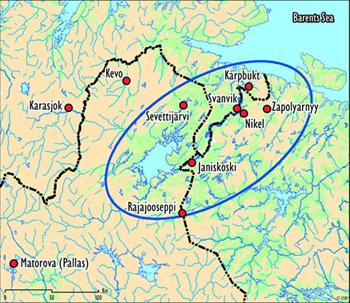Monitoring Programme
Air quality monitoring programme
 The sulphur dioxide (SO2) concentrations in the air are measured in order to quantify the concentrations of SO2 and to quantify the impacts of emissions on the acidification of the soil and watercourses and other environmental changes. Sulphur compounds have both health effects and effects on vegetation and, through acidification, also on the mobility of heavy metals.
The monitoring of deposition characteristics measured from rainwater is important partly for the same reason, but above all because of the toxic components it contains, such as heavy metals. Dust particles, either as total dust or particles with diameter less than 10 µm, are also collected to quantify dust in the air. On the basis of this data, it is possible to estimate the extent of air pollutants and to connect these pollutants with the impacts observed in the terrestrial and aquatic ecosystems.
The Norwegian monitoring program in the border area has monitoring stations at Svanvik and Karpdalen. These two stations continuously monitor basic meteorology, measure sulphur dioxide (SO2) in air and also heavy metals in air and precipitation. Water is collected for a period of one week, after which the heavy metals load (copper (Cu), nickel (Ni), cobalt (Co), lead (Pb), chrome (Cr), zinc (Zn) and arsenic (As)) is analyzed.
The measurement findings of Raja-Jooseppi, Kevo, Jäniskoski and Karpbukt, Andøya and Matorova in Pallas are also utilized. The latter two are background stations required for comparison purposes.
Need to supplement monitoring
The joint air quality monitoring of three nations initiated in 2007 is based on monitoring that has long been continued on the national level. This covers only some of the monitoring programme recommendations made by the environmental experts.
Supplementation of monitoring according to recommendations is important when there is a need to monitor the impacts of the renovation of the Pechenganikel Smelter on the environment. This requires continuous monitoring of sulphur dioxide and deposition loading at all three stations of the programme.
It is also necessary to incorporate the Russian Zapoliarny measurement station into the joint monitoring programme. In addition, a new monitoring station needs to be established northeast from the emissions sources downwind from the prevailing winds. However, one of the prerequisites is the comparability of measurement devices and methods with the practices of the other stations in the monitoring programme.
Currently, little is known about the sources and existence of persistent organic pollutants
(POPs)
The sulphur dioxide (SO2) concentrations in the air are measured in order to quantify the concentrations of SO2 and to quantify the impacts of emissions on the acidification of the soil and watercourses and other environmental changes. Sulphur compounds have both health effects and effects on vegetation and, through acidification, also on the mobility of heavy metals.
The monitoring of deposition characteristics measured from rainwater is important partly for the same reason, but above all because of the toxic components it contains, such as heavy metals. Dust particles, either as total dust or particles with diameter less than 10 µm, are also collected to quantify dust in the air. On the basis of this data, it is possible to estimate the extent of air pollutants and to connect these pollutants with the impacts observed in the terrestrial and aquatic ecosystems.
The Norwegian monitoring program in the border area has monitoring stations at Svanvik and Karpdalen. These two stations continuously monitor basic meteorology, measure sulphur dioxide (SO2) in air and also heavy metals in air and precipitation. Water is collected for a period of one week, after which the heavy metals load (copper (Cu), nickel (Ni), cobalt (Co), lead (Pb), chrome (Cr), zinc (Zn) and arsenic (As)) is analyzed.
The measurement findings of Raja-Jooseppi, Kevo, Jäniskoski and Karpbukt, Andøya and Matorova in Pallas are also utilized. The latter two are background stations required for comparison purposes.
Need to supplement monitoring
The joint air quality monitoring of three nations initiated in 2007 is based on monitoring that has long been continued on the national level. This covers only some of the monitoring programme recommendations made by the environmental experts.
Supplementation of monitoring according to recommendations is important when there is a need to monitor the impacts of the renovation of the Pechenganikel Smelter on the environment. This requires continuous monitoring of sulphur dioxide and deposition loading at all three stations of the programme.
It is also necessary to incorporate the Russian Zapoliarny measurement station into the joint monitoring programme. In addition, a new monitoring station needs to be established northeast from the emissions sources downwind from the prevailing winds. However, one of the prerequisites is the comparability of measurement devices and methods with the practices of the other stations in the monitoring programme.
Currently, little is known about the sources and existence of persistent organic pollutants
(POPs)
POPs |
Chalcophile elements combine readily with sulfur (sulfides) instead of oxygen (oxides).
Chalcophile elements include mercury, cadmium, arsenic lead and zinc, among others.PAHs |
Polyaromatic hydrocarbons (PAHs) are harmful substances, which are formed by incomplete combustion.
They are carcinogenic, mutagenic and teratogenic. PAHs are one of the most widely dispersed groups of harmful organic substances.Hg |
Mercury (Hg) is a metallic chemical element. Mercury, and especially organic mercury compounds, are extremely toxic, it bioaccumulates in living organisms and is biomagnified in the food chain.
People receive most of their mercury burden from fish.Ilmatieteen laitos
Norsk institutt for luftforskning
Мурманское Управление По Гидрометеорологии И Мониторингу Окружающей Среды
Images: Lapin ELY
